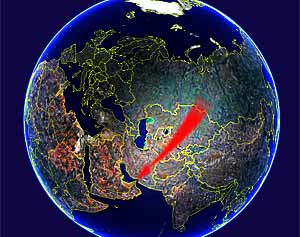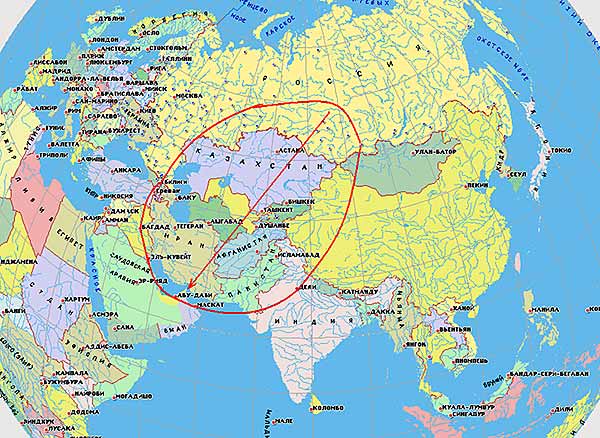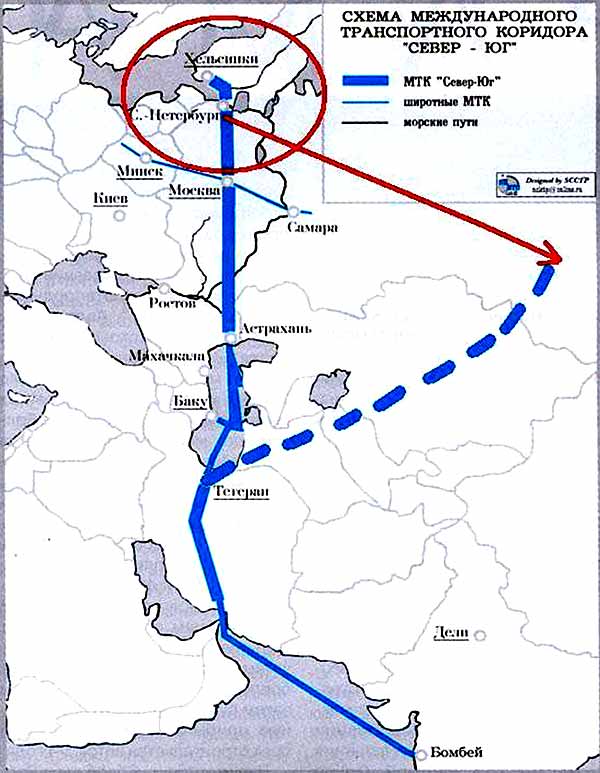06.12.2008
November 30, 2008 (The date of publication in Russian)
Yury Krupnov
THE NEW MIDDLE EAST: A MEGA-OBJECTIVE FOR RUSSIA
Purposeful integration of Afghanistan, Middle Asia and Siberia as a challenge of the new era
 THE GENERAL DESIGN OF THE NEW MIDDLE EAST
THE GENERAL DESIGN OF THE NEW MIDDLE EAST
In the oncoming twenty years, transformation of the whole territory of Central Asia, from Kazakhstan to the Persian Gulf in the west and northern India in the south-east, is going to become Russia's central geopolitical and diplomatic task.
Creation of a new macroregion, characterized with political stability and steady economic growth, should be achieved by means of a new industrialization on the base of systemic cooperation of Russia, India, China, Iran, Afghanistan, Pakistan, Mongolia, Kazakhstan, Turkmenia, Kyrgyzstan, Tajikistan, Azerbaijan, and Turkey.
The crucial mission of the design is to establish an integral geoeconomic and geocultural space, deliberately guaranteed from any repartition and re-division sought by egoistic interests of particular states. From a playground of geopolitical collisions and instrumental utilization in favor of particular interested sides, the macroregion should transform into the nucleus of the Central Asia common market, and a site of dialogue of civilizations and peoples. This macroregion should be identified as the New Middle East.
Only the New Middle East could resolve the following task, critically important for Russia and its neighbor nations:
1) to re-establish Afghanistan as an integral, sovereign and self-sufficient state, transforming from a hotbed of instability, drug cultivation, and terrorism into a model state of accelerated industrialization and development;
- to guarantee durable cooperative security and stability;
- to demilitarize the region, and prevent its use as a stronghold of NATO control over China, India, and Russia;
- to prevent a military assault on Iran, as a partner of the New Middle East design;
- to establish a fundamental geographic construction, essentially securing Russia from partition along the range of the Urals;
- to build an integral infrastructure of water supply of the region's southern lands for solving the crucial problem of fresh water;
- to build an integral educational space, similar to the Bologne Agreement, with a network of colleges and high schools of joint development designed for activity-oriented content of education;
- to organize an integral economic and infrastructural space, serving as a connection between Russia's Siberia with the "southern seas"(the Arabian Sea and the Persian Gulf), as an axis for the future land bridge between the Arctic and Indian Oceans.

Fig.1. The contour of the New Middle East
†
RUSSIA CAN'T ISOLATE ITSELF FROM PROBLEMS OF ASIA
Obviously, construction of the New Middle East is vitally important for Russia.
The popular view of liberal Russian strategists that Central Asia should serve as a "buffer zone", isolating Russia from "most unstable territories of the Middle East" is utterly discredited. The description of former Soviet republics of Central Asia as a "ballast" for Russia has proven short-sighted, inadequate, and morally unsound. The practice of the last decade proves that the attempt to "emancipate" from Central Asia result in exacerbation of instability in the region that tends to spread northward to the borders of Russia. This self-isolation leads to persistence and expansion of a narcoterrorist conglomerate involving not only Central Asian nations but southern regions of Russia as well. This tectonic instability is going only to increase unless Russia works out a new project vision. The Russian Federation has already encountered the problem of inflow of illegal immigrants, escaping from the disastrous social conditions in their Asian homelands.
Establishing the New Middle East is the only alternative to further dissemination of instability. From the start, the implementation of the new design will perform as a factor of cardinal reorganization of geoculture, geoeconomy, geopolitics, and geostrategy in Eurasia and the whole world.
†
THE BASIC PRINCIPLES OF THE PROJECT
Geoculture and geoeconomy are a top priority in implementation of the New Middle Asia design.
Firstly, the New Middle East is unattainable without cultivation of a new set of values emerging around the principle of dialogue of civilizations and peoples for the sake of joint development.
Secondly, the New Middle East design requires construction of a common market – a new economic community implementing projects of comprehensive industrialization and elaborating new standards of quality of life for the territory with a 400 mln population.
Types of optimal industrialization will significantly vary in the regions of the New Middle East. Siberia requires a tertiary industrialization aimed at a breakthrough into the seventh technological mode, with dissemination of technologies of directed increase of quality of life and a society of science, while some southern regions are subject to primary industrialization.
The basis of the new economic space is going to be built on an integral infrastructure of electric energy, irrigation and water supply, management of commodity transfer and fostering employment.
For this purpose, it is essentially significant to build a railway link connecting Siberia, Kazakhstan, Turkmenia, and Iran. The most feasible route of 800 km would extend from Uzen, Kazakhstan, southward to Bereket, Etrek and Gurghen (Turkmenia) and to Meshed (Iran) continuing into a trans-Afghan line via Herat and Kandahar to reach Quetta in Pakistan.
†
THE NORTH-SOUTH TRANSPORT CORRIDOR
Therefore, the intention, design and the very geography of the broadly discussed project of the North-South transport corridor should be revised. Originally, we spoke about the direct water-railroad connection of the Baltic Sea, the Volga, the Caspian, and the Persian Gulf. However, the original intention Ц "to connect India with Europe across Western Russia") Ц appeared to be hardly implementable. Moreover, this concept ignores the necessity to develop the regions of Siberia and the Far East.
Translocation of the northern point of the axis from the utmost North-West of Russia to the Arctic coast of Siberia opens essentially new economic and geopolitical opportunities.
†
Fig.2. The shift of the destination and direction of the North-South transport corridor
†
THE GEOECONOMY OF WATER
Other projects of transportation, including transfer of fresh water indispensable for the region's industrialization, are of top priority. The region cannot durably survive without inflow of water from Siberian rivers.
For establishing durable peace in Afghanistan, a new irrigation system is vitally important. However, the redirection of flows from the basin of Amudarya to this region would deteriorate water supply of adjacent nations Ц Turkmenia and Uzbekistan, as well as Pakistan. Therefore, the project of the Great Turn of Siberian rivers, particularly the transfer of 1/20 portion of Ob's debit to Central Asia, should be returned to the practical agenda. This megaproject is outline, in particular, in the study "Water and Peace" authored by Moscow Mayor Yury Luzhkov.
This project is designed as the axis of the Siberia-Iran development corridor. Beside advantages of international security, the project provides fantastic opportunities for new development of Siberia through access to the Southern seas, emergence of gigantic Middle East and South Asia markets, along with a new demand for Siberian science and technology.
Moreover, creation of the New Middle East in fact comprises the practical, physical subject of activity of the Shanghai Cooperation Organization that has lately ascended to the level of project thinking with particular territorial applications. The latest SCO summit has emphatically raised the issue of activating the SCO-Afghanistan Contact Group, entrusted to convene a special Afghanistan Conference focused on security interests and anti-drug policy. This intent, earlier expressed in the August 28 Dushanbe Declaration, should be completed with physical economy agenda.
†
A NEW OPPORTUNITY FOR RUSSIAN LEADERSHIP
For Russia, the doctrine of the New Middle East represents also a most favorable pretext for transition to export of development as a political strategy.
A new Eastern policy, based on development, would serve as a positive alternative to the so-called "export of democracy" that had proven its utter inefficiency. In effect, "export of democracy" resulted in export of financial and economic crisis on the background of earlier militarization that summarizes in export of instability.
Meanwhile, Russia possesses a unique opportunity to place its traditional role of a catalyst of development in adjacent countries in the center of its foreign policy. The international propagandist campaign of ostracizing Russian imperialism, launched in fact by the hugest empire in the world, has unfortunately overshadowed the civilizational role of Russia in the countries it had patronized in various periods of history, as well as the immense economic and cultural result of this patronage.
This feature, inherent in Russian foreign policy and implemented in the physical economic expression of its national mission, is to be rehabilitated and exercised anew in the form of a deliberate export of development. The New Middle East is a perfect space for implementation of this doctrine, rooted in the centuries-long tradition.
A number of statements, recently made by Russian leaders, indicate the presence of preconditions for accepting this doctrine on the governmental level. Addressing the meeting of heads of SCO governments on October 30, Russian Prime Minister Vladimir Putin reminded that "sets of values and models of development are [again] becoming a subject of competition. We have to join our efforts in transformation of the global and regional architecture of security and development, adapting it to the reality of the XXI century, in which stability and prosperity are viewed as indivisible criteria".
The doctrine of the New Middle East enables Russia to develop a system of dirigistic implementation of three programs applied to "three Easts":
- the Russian Far East, rapidly rising and transforming into a center of global development, a leading region of the world, and thus a locomotive of the whole Russia's progress;
- the Russian Near East, i.e. Russia's relations with European and international institutions in the former Socialist community of Eastern Europe;
- the New Middle East.
Authors, discussing the problem of so-called limitrophic countries, overlook differences between these countries, as well as the role they can play in Russia's domestic development. In particular, the solution of North Korea's problem can be seen in the construction of a new modern city in the Khasan District of Primorsky Kray with industry based on advanced biological and biomedical technologies.
Thus, a more expansive foreign policy, expressing a transition from "Russian federative nationalism" to a doctrine of Russia as a global power, is essential both for the whole nation's security and for accelerated development of particular regions.
†
THE NEW GEOGRAPHIC LANGUAGE
In Western literature, the term "Middle East" is most commonly applied to what Russians identify as "Blizhny Vostok" Ц Near East. It is noteworthy that in Russian classical geographic science, the term "Sredny Vostok" Ц literally Middle East Ц had been traditionally applied to the heartland of Asia, populated by the indigenous Persian and the ecdemic Turcic peoples. According to Russian geographer Andrey Snesarev, "the Middle East (Sredny Vostok) is not an invention or artificial design but a definition of a particular geographical entity".
In 1921, Snesarev indicated that the cultural identity of Persian and Turcic peoples determines the specific character of nations formed in the region between the borders of the Gulf states, today's India, and China.
The nations that emerged in Central Asia after USSR's disintegration are naturally gravitating to this culture. Meanwhile, Western nations, often with assistance from Gulf states, are trying to attract these nations into their orbit of influence and political designing. These efforts, purposed primarily for disrupting economic and cultural connections between these countries and Russia, have most convincingly proven the inadequacy of Washington's "export of democracy" and most illustratively exposed the imperialist background of these efforts.
Under these circumstances, it makes perfect sense for Russia to develop and implement an integrationist project, providing access for Central Asia to the region internationally determined as Middle East, in the framework of Russian strategic interests.
It is noteworthy that this integration is going to happen in any case. Besides, the most sensitive problem of Afghanistan cannot be solved without establishing this link. In his review of Snesarev's book "Avganistan" (the author insisted on this spelling), prominent Orientalist Igor Reisner indicated that Afghanistan's problem can't be adequately approached unless the whole problem of Central Asia is solved.
To avoid misinterpretations of the term "Middle East", it makes sense to introduce the Russian analogue into international language. The word "vostok", the Russian for "East", was in fact learned by the global audience in 1961 along with the name of Yury Gagarin, the pilot of the first manned spaceship.
The task of construction of a new flourishing macroregion in the currently war-ridden and socially unstable expanse is as ambitious as the first space flight. The design of Novy Sredny Vostok (New Middle East) requires a similar level of human creativity.
Number of shows: 4306
rating:
3.44
 ENG
ENG 

 ENG
ENG 
